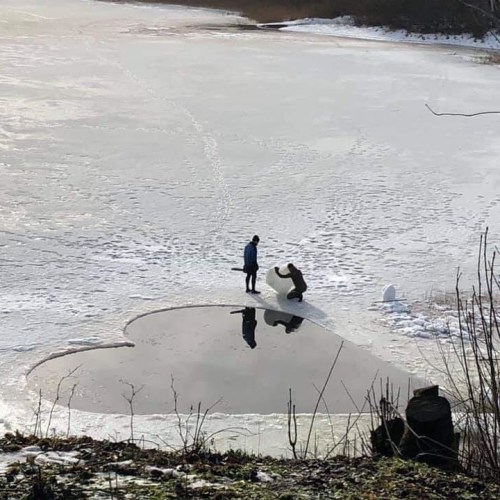Sub Surfaced In Frozen Waters

Sub surfaced in frozen waters
More Posts from Flurries-and-frost and Others










Planet E A R T H by :
© b.simon

Examples of Inuit clothing. The ironic problem of wearing linen and cotton clothing in the arctic was sweat. Activities such as manhauling, warping the ship, and preparing camp were strenuous, and the men would sweat from the exertion. The problem came when they stopped. In low arctic and Antarctic temperatures the sweat would freeze almost instantly, leaving the unfortunate individual wearing what was more or less a sheet of ice.This, of course, ended in frostbite and hypothermia. Several explorers accounts recall clothing and sleeping bags that were like sheets of iron, thawed only with more exertion. The Inuit not only relied on dogs for hauling thus saving unnecessary exertion, they also overcame that tropical adaptation to cooling off all humans have with their clothing. Hides do not absorb sweat as readily, and were softened by chewing. Anoraks also are designed to ventilate, as discovered and described by Amundsen when he began wearing Netchili clothing. The air running through it evaporates the sweat and ends up leaving the wearer virtually free of ice garments.

“The ice was here, the ice was there, The ice was all around.” (S. T. Coleridge)
A digital painting based on a 19th century engraving.
Print available on Inprnt


BOB KUHN Seal Hunter Acrylic 24″ x 36″


-
 frankensteincreations reblogged this · 1 year ago
frankensteincreations reblogged this · 1 year ago -
 frankensteincreations liked this · 1 year ago
frankensteincreations liked this · 1 year ago -
 legendaryhologramavenue reblogged this · 1 year ago
legendaryhologramavenue reblogged this · 1 year ago -
 totorococo reblogged this · 2 years ago
totorococo reblogged this · 2 years ago -
 corse2b liked this · 3 years ago
corse2b liked this · 3 years ago -
 paddy0121 liked this · 3 years ago
paddy0121 liked this · 3 years ago -
 theseeker1864 reblogged this · 3 years ago
theseeker1864 reblogged this · 3 years ago -
 theseeker1864 liked this · 3 years ago
theseeker1864 liked this · 3 years ago -
 howlingday liked this · 3 years ago
howlingday liked this · 3 years ago -
 tuapao reblogged this · 3 years ago
tuapao reblogged this · 3 years ago -
 eisbar777 reblogged this · 4 years ago
eisbar777 reblogged this · 4 years ago -
 eisbar777 liked this · 4 years ago
eisbar777 liked this · 4 years ago -
 milkphlants liked this · 4 years ago
milkphlants liked this · 4 years ago -
 homosexualisopod liked this · 4 years ago
homosexualisopod liked this · 4 years ago -
 yunatheintrovert reblogged this · 4 years ago
yunatheintrovert reblogged this · 4 years ago -
 yunatheintrovert liked this · 4 years ago
yunatheintrovert liked this · 4 years ago -
 emmastarlight liked this · 4 years ago
emmastarlight liked this · 4 years ago -
 otherwise-called-squidpope reblogged this · 4 years ago
otherwise-called-squidpope reblogged this · 4 years ago -
 xbubblehead liked this · 4 years ago
xbubblehead liked this · 4 years ago -
 kittycactii liked this · 4 years ago
kittycactii liked this · 4 years ago -
 myakiss liked this · 4 years ago
myakiss liked this · 4 years ago -
 fr33floating liked this · 4 years ago
fr33floating liked this · 4 years ago -
 quma0 reblogged this · 4 years ago
quma0 reblogged this · 4 years ago -
 spolly01 liked this · 4 years ago
spolly01 liked this · 4 years ago -
 assterixs liked this · 4 years ago
assterixs liked this · 4 years ago -
 flurries-and-frost reblogged this · 4 years ago
flurries-and-frost reblogged this · 4 years ago -
 inthe-darkofthe-night liked this · 4 years ago
inthe-darkofthe-night liked this · 4 years ago -
 brunahemmes liked this · 4 years ago
brunahemmes liked this · 4 years ago -
 scurvyeunuch reblogged this · 4 years ago
scurvyeunuch reblogged this · 4 years ago -
 beautfoto reblogged this · 4 years ago
beautfoto reblogged this · 4 years ago -
 wachsurfer2018 liked this · 4 years ago
wachsurfer2018 liked this · 4 years ago -
 beautfoto liked this · 4 years ago
beautfoto liked this · 4 years ago -
 johnnywooh reblogged this · 4 years ago
johnnywooh reblogged this · 4 years ago -
 dtedg43 reblogged this · 4 years ago
dtedg43 reblogged this · 4 years ago -
 johnnywooh liked this · 4 years ago
johnnywooh liked this · 4 years ago -
 silenthamish reblogged this · 4 years ago
silenthamish reblogged this · 4 years ago

